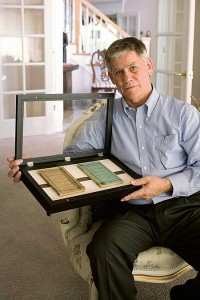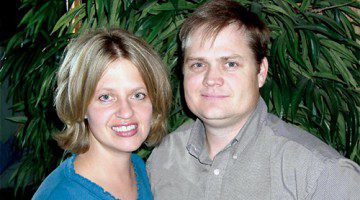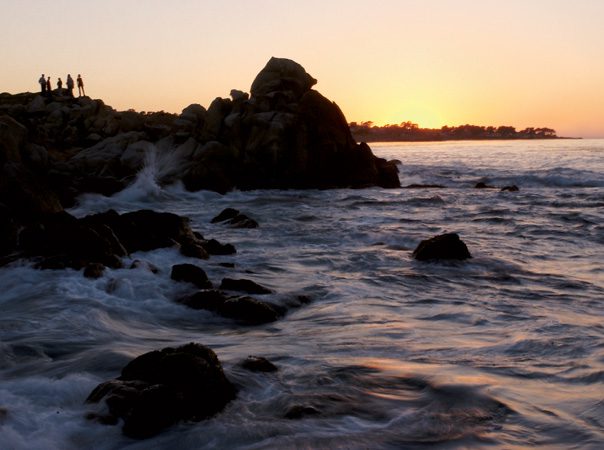
Fernando Gomez displays copies of the first Spanish translation of the Book of Mormon, two of his 250,000 artifacts related to Mexican Church history.
Across the street from the Provo Temple, a baby blue ’55 Chevy Convertible sits in the garage of Fernando R. Gomez (BS ’67). It is a symbol of his hard-working youth, in which he and his brother delivered 1,000 newspapers a day on foot before working their way up to bicycles, motorcycles, a car, and then the cherished convertible.
One of many collectibles in this house, the Chevy brings a sparkle to Gomez’s eye, but it is hardly the possession he most values. To see that, you have to go to the basement.
There, just beyond Gomez’s handcrafted table, lies the largest collection of artifacts related to the history of The Church of Jesus Christ of Latter-day Saints in Mexico. He has filled the entire room with the valuables, and he’s cataloging every single one—250,000 items and counting.
It’s a painstaking task, for which Gomez puts in eight to 12 hours of data entry each day, but the result is a searchable computer database that has already provided the descendants of early Church members in Mexico with a record of their ancestors’ faith.
“How many historians have cataloged the life of Joseph Smith? Thousands,” says Gomez. “But this is unique. We’re the only ones to ever do something like this.”
A sampling of the keepsakes in Gomez’s care includes the original manuscript written by Plotino Constantino Rhodakanaty that was used by Apostle Moses Thatcher in publishing one of the first Church pamphlets in Spanish; meeting agendas and genealogical records; and the first complete Spanish translation of the Book of Mormon, done in Logan, Utah, in 1886 by Meliton Gonzalez Trejo and James Zebulon Stewart. More than 4,000 pictures dating from the 19th century also form part of the collection.
The relics are normally housed at the Museum of Mormon History in Mexico, a nonprofit, privately funded institution founded by Gomez 15 years ago. It stands directly across the street from the Mexico City Mexico Temple and welcomes more than 12,000 visitors each year free of charge.
Gomez began with a modest collection of aging documents and photographs that had been saved and passed down by his Aunt Consuelo, a schoolteacher in Pachuca, Hidalgo, Mexico. “She is the inspiration for all this,” he says, and he holds Consuelo’s journal dear. “It was suggested that we send it all up to Salt Lake, but then my wife said, ‘Why don’t we keep it here in Mexico, let the people of Mexico have access to it.’”
Gomez did, and he put out a call for more memorabilia. “We’ve been able to collect much Church history paraphernalia that would otherwise be destroyed by now,” he says. The artifacts are only in Utah temporarily for exhibitions and scanning.
As Gomez continues to collect and compile, he emphasizes that he is preserving a history much grander than his own. “This is a great work,” he says.









